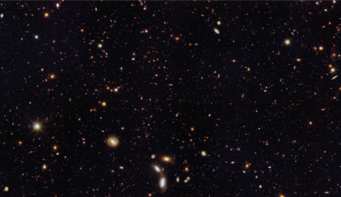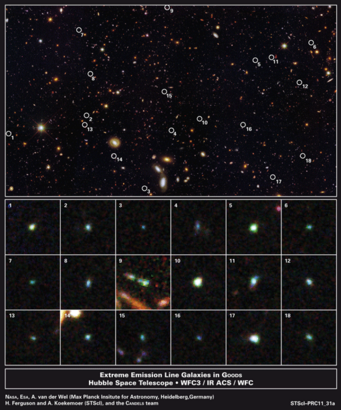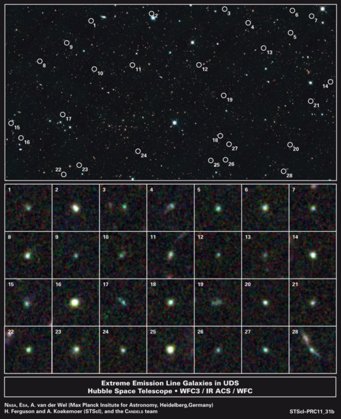Unusually productive dwarf galaxies pose a riddle,
but could solve another
Using the Hubble Space Telescope, a team of astronomers led by Arjen van der Wel of the Max Planck Institute for Astronomy (MPIA) in Heidelberg has looked back into the early universe to discover a population of small, young galaxies that produce new stars at an extraordinary rate. For current models of galaxy formation, this high star production rate is difficult to explain. It could, however, serve to solve another dwarf galaxy riddle: The unusual distribution of Dark Matter within these cosmic objects. The results will be published in the November 10 edition of the Astrophysical Journal.
| Background information | Questions & Answers | Image download |
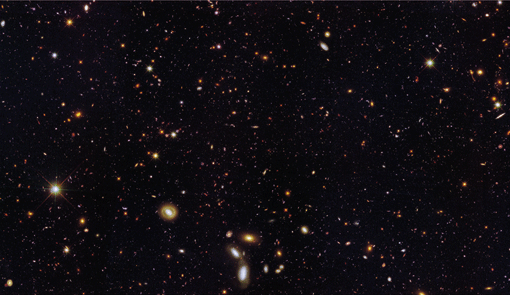
Dwarf galaxies, with masses around one hundredth of the mass of our home galaxy, the Milky Way, are the most common type of galaxy in the cosmos, and their study can reveal important clues about galaxy formation in general.
When it comes to celestial objects, distant dwarf galaxies are rather faint and small, and thus hard to detect. Up until now, very few examples were known, the result of dedicated telescope observations focusing on small patches of the sky. Enter the CANDELS survey, the largest project in the history of the Hubble Space Telescope. Over three years of observations (2010-2013), CANDELS is set to examine the most distant galaxies in the universe.
When it came to dwarf galaxies, the astronomers were in for a surprise: "We found a population of 69 dwarf galaxies that stood out because of their unusual colours" says Arjen van der Wel (MPIA), the lead author of the new study. Due to their great distance, astronomers see these dwarf galaxies as they were nearly 10 billion years ago (redshift z ~ 1.7).
As subsequent studies of the spectra of four of these galaxies confirmed, the unusual colour of these objects is due to the fact that they are producing new stars at a surprisingly high rate – it would take such a galaxy only about 15 million years to double the number of stars; in contrast, it would take our Milky Way galaxy 1000 times as long.
This provides a key piece of the puzzle of galaxy evolution. MPIA director Hans-Walter Rix explains: "Through 'archaeological' studies of nearby dwarf galaxies, carefully tracing stellar ages, astronomers already knew that most of those galaxies' stars formed more than 8 billion years ago. What they didn't know was whether star formation proceeded slowly or quickly." The new results indicate that stars are likely to have formed quickly, with each galaxy undergoing but a few periods of rapid star formation.
While some simulations of dwarf galaxy evolution show episodic bursts of star formation, none of those are intense enough to explain the observed very high formation rate. Thus, the new findings pose a difficult challenge to current models of galactic evolution.
Whereas these dwarf galaxies' high star-formation rate constitutes itself a cosmic riddle, it could help to clear up another, more long-standing mystery concerning the distribution of Dark Matter in galaxies. By mass, Dark Matter accounts for more than 80% of matter in the universe, while ordinary atoms (including the ones we are made of) account for less than 20%. Dark Matter plays a key role in the way that, over the 13.7 or so billion years of cosmic evolution, an initially fairly homogeneous universe condensed to form galaxies and galaxy clusters.
But simulations of galaxy evolution give a result that is at odds with observations: It predicts that dark matter should be concentrated significantly towards the center of a galaxy ("cusp profile"). Observations, on the other hand, have shown a much more even distribution of Dark Matter. As early as 1996, astronomers (Navarro et al.) had surmised that this distribution could have evolved as ordinary matter was blown outwards from the galaxy, pulling some of the Dark Matter along. The newly discovered intense bursts of star-formation activity in dwarf galaxies provide the most direct evidence to date that this is a suitable way of resolving the discrepancy between models and observations.
Background information
The work described here is slated for publication as van der Wel et al., "Extreme Emission Line Galaxies in CANDELS: Broad-Band Selected, Star-Bursting Dwarf Galaxies at z > 1" in the November 10, 2011 issue of the Astrophysical Journal.
The co-authors are A. van der Wel (MPIA), A. N. Straughn (Goddard Space Flight Center), H.-W. Rix (MPIA), S. L. Finkelstein (Texas A&M University), A. M. Koekemoer (STScI), B. J. Weiner (Steward Observatory), S. Wuyts (Max Planck Institute for Extraterrestrial Physics), E. F. Bell (University of Michigan), S. M. Faber, J. R. Trump, and D. C. Koo (all USCS), H. C. Ferguson (STScI), C. Scarlata (University of Minnesota), N. P. Hathi (Observatories of the Carnegie Institution of Washington), J. S. Dunlop (University of Edinburgh), J. A. Newman (University of Pittsburgh), M. Dickinson (NOAO), K. Jahnke (MPIA), B. W. Salmon (Texas A&M University), D. F. de Mello(The Catholic University of America and Goddard Space Flight Center), D. D. Kocevski and K. Lai (both UCSC), N. A. Grogin (STScI), S. A. Rodney (Johns Hopkins University), Yicheng Guo (University of Massachusetts), E. G. McGrath (UCSC), K.-S. Lee (Yale Center for Astronomy and Astrophysics), G. Barro (USCS), K.-H. Huang (Johns Hopkins University), A. G. Riess (STScI and Johns Hopkins University), M. L. N. Ashby and S. P. Willner (both Harvard-Smithsonian Center for Astrophysics).
The Cosmic Assembly Near-infrared Deep Extragalactic Legacy Survey (CANDELS) is a powerful survey of the distant universe being carried out with the Hubble Space Telescope (HST). The largest project in the history of Hubble, it has been allocated a combined exposure time of 4 months. CANDELS uses to instruments aboard the HST: the near-infrared WFC3 camera and the visible-light ACS camera. Jointly, these two cameras give unprecedented coverage of galaxies from optical wavelengths to the near-infrared. This will allow CANDELS to study different stages in the formation of galaxies, from the first billion years of cosmic evolution to the present. In addition, CANDELS is set to explore the properties of Dark Energy, the little-understood cosmic ingredient responsible for the acceleration of cosmic expansion, by measuring the brightness of supernovae of type Ia – continuing work for which CANDELS team member Adam Riess, who is also a co-author of the present work, was awarded the 2011 Nobel Prize for physics.
Additional information can be found at these links:
• http://adsabs.harvard.edu/abs/2011arXiv1107.5256V – ADS data base entry for the journal article
• http://hubblesite.org/news/2011/31 – Hubble Space Telescope news release
• http://candels.ucolick.org/ – homepage of the CANDELS survey
Questions and Answers
Which telescopes were used in this research?
The observations were made as part of the CANDELS survey with the Hubble Space Telescope (HST). The 69 dwarf galaxies were discovered in near-infrared images taken with the HST's Wide Field Camera 3 (WFC3) and Advanced Camera for Surveys (ACS); spectral measurements for 4 of the galaxies were made with the WFC3.
The HST is a project of international cooperation between NASA and the European Space Agency. NASA's Goddard Space Flight Center manages the telescope. The Space Telescope Science Institute (STScI) conducts Hubble science operations. STScI is operated for NASA by the Association of Universities for Research in Astronomy, Inc. in Washington, D.C.
Where are the observed galaxies located in the sky?
The galaxies were found in two regions of the sky: one is the region of the Great Observatories Origins Deep Survey-South (GOODS), located in the Southern constellation Fornax and about one fifth as large as the area covered by the full moon in the sky. The other is the area of the UKIDSS Ultra Deep Survey, which is part of the UKIRT Infrared Deep Sky Survey, located in the constellation Cetus. This region covers about four times the area of the full moon.
In the GOODS-South field, CANDELS looked at an area approximately 15% the size of the full moon (the area shown in figure 2 corresponds to 10% full moon size). In the UDS field, CANDELS examined an area about 20% the size of the full moon.
How can the star formation rate be measured?
Different stages of star formation can be measured in different ways, a number of which involve so-called emission lines – narrow regions within the electromagnetic spectrum where an object emits much more radiation than at neighbouring wavelengths.
Some specific emission lines (e.g. molecular lines associated with carbon monoxide, CO) are associated with matter collapsing to form new stars. Others, such as the O III lines (from oxygen atoms that are missing two electrons) that are important for this particular study, are formed when young, very hot stars are already present, and their intense ultraviolet radiation "blows away" electrons from whatever oxygen atoms might be present. Oxygen atoms that have just lost 2 electrons will typically not be in the state of lowest possible energy; instead, they will emit radiation at very specific wavelengths, leading to O III emission lines that glow with a very particular green colour.
In the present study, star formation rates are estimated using information about this kind of O III emission, indicating the presence of hot, young stars which, in turn, is a tell-tale sign of ongoing star formation. For galaxies as distant as those under study here, cosmic expansion has "redshifted" the green colour of the oxygen lines by a significant amount: O III emission from these galaxies reaches us as near-infrared radiation. This is the reason these objects were not discovered in earlier observations: CANDELS is the first infrared survey that is capable of detecting sources as faint as glowing oxygen atoms at the other end of the universe.
For four of the galaxies, O III emission was traced directly in spectra taken with the HST's Wide Field Camera 3. For the other galaxy, the presence of O III radiation was reconstructed from the tint it imparts to the galaxies' overall colour.
What further directions for research do these results suggest?
The CANDELS observations are an ideal candidate for follow-up observations with the Hubble Space Telescope's designated successor, the James Webb Telescope, due to be launched later this decade.
"With Webb, we'll probably see even more of these galaxies, perhaps even pristine galaxies that are experiencing their first episode of star formation," says Harry Ferguson of the Space Telescope Science Institute (STScI) in Baltimore, Md., co-leader of the CANDELS survey. "Being able to probe down to dwarf galaxies in the early universe will help us understand the formation of the first stars and galaxies."
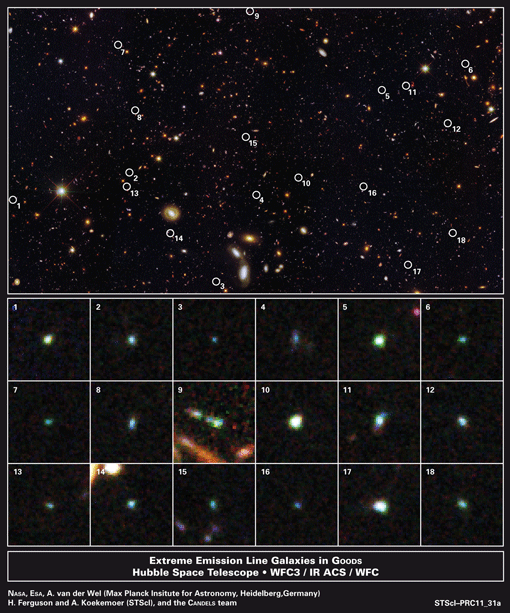
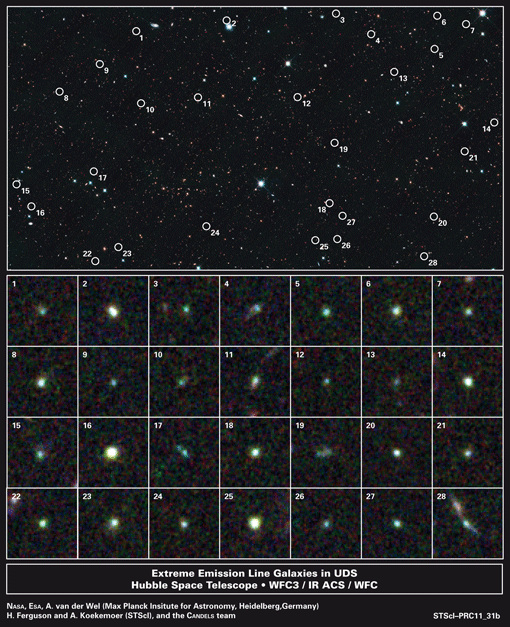
Download area



